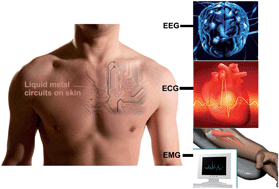Rapidly patterning conductive components on skin substrates as physiological testing devices via liquid metal spraying and pre-designed mask
Abstract
The newly emerging skin-electronic devices with flexible features are usually fabricated on a very thin substrate, which do not directly contact the skin. This may generate large coupling impedance with the skin and a high signal noise for a sensitive detection of weak physiological signals. Here, in an alternative manner, we propose a method to directly pattern liquid metal conductive components as sensors on skin through a spray-printing strategy. This quick way of making flexible electronics on skin is enabled via a stainless mask that is pre-designed by chemical etching with line width resolution of 100 μm and can be used to deposit desired electrical components. Several typical geometric metal graphics, spanning from simple to complex structures, which serve to compose complex electrical circuits or devices, are fabricated in a moment. Particularly, GaIn24.5-based liquid metal wires deposited on pig skin under different conditions were quantified, and the mechanisms for the spray-printing of bioelectronics were interpreted. Further, stretching experiments were performed, which show that the resistance of the printed film would take a square growth with the tensile length of the pig skin in a specific range. Finally, an inter-digital array (IDA) electrode sensor with the distance between two inter-digital fingers of 0.5 mm and the length of the finger of 11 mm was fabricated and applied to measure impedance spectroscopy of pig skin. This study demonstrates the unique value of the present Lab on Skin for physiological measurement. It illustrates a promising route for directly printing electronics pattern on skin that will be very useful for a wide variety of practical situations such as skin sensors, actuators, skin electrical circuits, etc.


 Please wait while we load your content...
Please wait while we load your content...